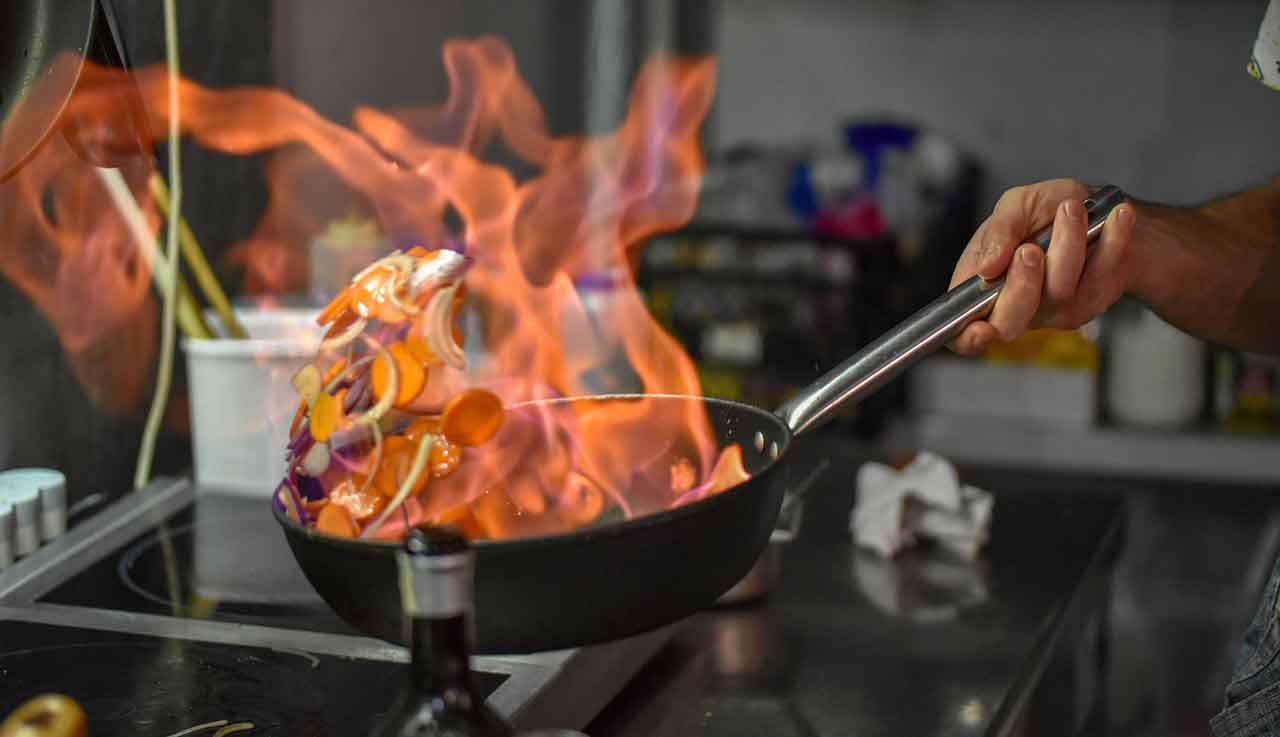Boo! How to scare up extra profits with a ghost kitchen.

Have you heard about ghost kitchens and virtual restaurants? These new ways of operating restaurants are gaining popularity, thanks to the pandemic.
Three new restaurant terms to know.
There are a few key terms to keep in mind to understand this new trend. Note that these terms are relatively new and you may see them used differently elsewhere.
Ghost kitchen
A shared kitchen that can be used by multiple restaurants to prepare food for delivery services.Virtual restaurant
A restaurant where customers can only order delivery items via delivery services. Virtual restaurants can be a restaurant’s second storefront to try out new recipes or reach new markets or can be a standalone virtual restaurant that rents space in a ghost kitchen.Virtual brand
According to Synergy Restaurant Consultants: “A virtual brand is a delivery-only food concept sold exclusively online with no physical space for guests to interact with the brand. A single restaurant can have multiple virtual brands running out of their facility with all meals produced in their existing kitchen.”
To further illustrate the concept, it is helpful to consider a few examples of how restaurants are adapting.
Independent restaurant innovation.
These independent, non-chain restaurant owners and chefs are finding new opportunities to create and sell food.
Baked Wings
In Illinois, Scott Frank launched virtual restaurant Baked Wings. To compete against other companies, Baked Wings makes their chicken wings with rubs instead of sauces so that the food stays crisp.Livy’s Plant-Based Foods
In Philadelphia, Jose Garces developed a plant-based virtual restaurant called Livy’s Plant-Based Foods.Tasting India
Jasmine Sheth created Tasting India in 2020 after losing her chef job. Sheth releases a new menu weekly that’s promoted in an email newsletter and on Instagram. Customers can then order the dishes they want from that week’s menu.Cypress Southern Kitchen
Based in Bend, Oregon, Susan Harrell created Cypress Southern Kitchen with a focus on Southern dishes like fried buttermilk chicken, braised short ribs and flourless chocolate cake.
Ways to use a virtual restaurant concept.
There are several ways to use the ghost kitchen methodology to grow a restaurant business.
- Launch virtual brands. For a restaurant that wants to offer different menu items and pricing strategies, launching a virtual brand through a ghost kitchen is an option. Even though Dog Haus sells chicken sandwhiches and plant-based foods, it noticed that it did not appear in delivery apps when customers searched for the terms. That’s because delivery apps tend to limit the number of keywords a restaurant can use to describe itself. To get around this, Dog Haus created two virtual restaurant brands: Plant B for plant-based foods and Bad Mutha Clucka to sell chicken sandwhiches.
- Earn revenue from existing kitchen facilities. Some hotels are exploring the ghost restaurant concept because they see it as a way to earn revenue from their kitchen facilities. For example, a restaurant entrepreneur is paying $6,000 per month for a fully outfitted catering kitchen at a New York hotel. There are new services like Use Kitch that has been described as an “Airbnb for the restaurant industry.” Approximately half of the rental kitchens available through Use Kitch as of January 2021 are inside hotels in New York. According to the New York Times, less than 5% of hotels are running ghost kitchens, so there is potential for further growth.
- Spend less to test menu items. According to US Foods, building a brand-new restaurant involves significant costs ranging from $750,000 to $1.2 million in an urban area. By contrast, one estimate from US Foods suggests that leasing a commissary-style ghost space may only require $50,000 in initial fees. Since a ghost kitchen generally has lower costs, a restaurant entrepreneur may be able to test multiple menu concepts to see which ideas win in the marketplace.
- Avoid front-of-house restaurant expenses. A traditional restaurant offers seating and wait staff for customers, while a new virtual restaurant does not offer these amenities. A company with a virtual restaurant model can avoid paying for the staff and space associated with a dining room.
Ghost kitchen disadvantages.
While a ghost kitchen offers opportunities, it is helpful to keep the disadvantages in mind as well.
- Additional costs. There are costs related to third-party commissions and packaging to make the ghost kitchen model work. Dozens of U.S. jurisdictions have imposed a cap on delivery commissions at 15%. However, some services charge 20-30% per order in commissions. As a result, many restaurants have increased their prices to offset these fees. A restaurant owner may want to compare and contrast the cost of hiring their own delivery staff vs. using a third-party delivery app. Ghost kitchens still have a cost advantage over traditional restaurants in terms of having lower startup costs (i.e., less need to purchase and equip a kitchen).
- Reduced control over customer interactions. Virtual restaurants commonly rely on third-party delivery services who interact with customers. As a consequence, it may be difficult for a restaurant owner to receive customer feedback. This disadvantage can be partly mitigated by starting a loyalty program and using coupon codes to connect with customers.
- Not all foods work well for delivery. A virtual restaurant model is limited in terms of what it can offer because some food items do not travel well. For reference, the most popular food items for delivery and takeout include burritos, tacos and pizza.
- Higher reliance on digital marketing. Generally speaking, the virtual restaurant model tends to emphasize the internet and social media in its business strategy. Higher reliance on digital marketing is a disadvantage for restaurateurs who lack expertise or experience with digital marketing methods. You can get started in digital marketing by using search ads and local search engine optimization.
Multiple ways to use the ghost restaurant concept.
Ghost kitchens offer restaurant owners and entrepreneurs some attractive options. For instance, a restaurant owner with spare kitchen capacity could earn revenue by selling access to their kitchen facilities. Alternatively, a restaurant owner looking to expand their takeout and delivery service could launch a virtual brand and earn further revenue.

Learn more about how Ooma Office can help your business.
Thank you!
An Ooma Office Sales Representative will be in touch shortly.
866-573-0707


Learn more about how Ooma Office can help your business.
Just call 877-621-0515 or click this to CHAT. Or, fill out this form and someone will reach out to you shortly.



